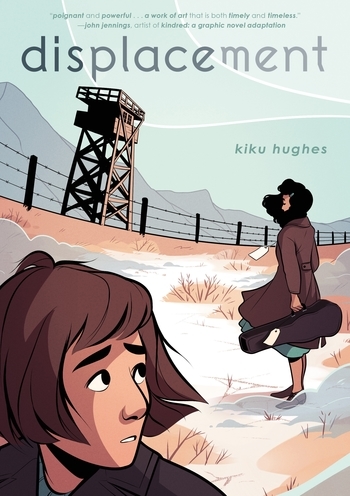A Review of Kiku Hughes's Displacement
![[personal profile]](https://i.gr-assets.com/images/S/compressed.photo.goodreads.com/hostedimages/1491408111i/22407843.png) jacobballew
jacobballew

Kiku Hughes’s Displacement (First Second, 2020) is a graphic novel I had waited to read until I needed a true mental break. A former student of mine, Stephanie Otani-Sunamoto, had recommended it highly, so I knew it was going to be good. Let’s let MacMillan’s official marketing description get us started:
“A teenager is pulled back in time to witness her grandmother's experiences in World War II-era Japanese internment camps in Displacement, a historical graphic novel from Kiku Hughes. Kiku is on vacation in San Francisco when suddenly she finds herself displaced to the 1940s Japanese-American internment camp that her late grandmother, Ernestina, was forcibly relocated to during World War II. These displacements keep occurring until Kiku finds herself ‘stuck’ back in time. Living alongside her young grandmother and other Japanese-American citizens in internment camps, Kiku gets the education she never received in history class. She witnesses the lives of Japanese-Americans who were denied their civil liberties and suffered greatly, but managed to cultivate community and commit acts of resistance in order to survive. Kiku Hughes weaves a riveting, bittersweet tale that highlights the intergenerational impact and power of memory.”
The hook of the story is obviously the time traveling component. Early on, it only seems as though San Francsico’s fog seems to be a kind of trigger, but it becomes apparent that the fog isn’t really the issue. Eventually, Kiku is just stuck in the past, having to endure the internment alongside her grandmother (Ernestina Teranishi), someone who was a talented violinist but that Kiku did not know much about. For those of us who study Asian American history and representation, the general context of the internment camps is something we understand well, as it has been written about in numerous texts at this point. At the same time, Hughes adds a couple of distinct elements to this story. First, she adds to the visual field of internment representations, one that has been primarily shouldered by Mine Okubo. Second, Hughes does add a potentially speculative tool in her storytelling related to time travel. This latter element I found immensely compelling, and it’s no surprise that Hughes is a big fan of Octavia Butler’s Kindred, as there are obvious parallels. On the whole, the story is immensely engaging, and readers will be absolutely riveted by Kiku’s experience, her challenges, and her desires to make something of a traumatic past. At the same time, the concluding arc begins to suggest the time travel is more of a metaphor than anything literal. This development I found a little bit disappointing only insofar as the figurative dimension of time travel was already coded into what was occurring. There is a psychic reckoning with a past that has been only partially excavated thus far. To time travel becomes a figurative mode by which to work through the silencing of this event in one family. Besides my minor gripe—and don’t we readers always have our nitpicky gripes—the visuals were absolutely stunning, and the narrative is one I’ll be sure to adopt in future courses. Next semester, I will be teaching a graphic novel course, and you can bet your bottom dollar that I will be teaching Displacement!
Buy the Book Here:
https://us.macmillan.com/books/9781250193537
 comments
comments



